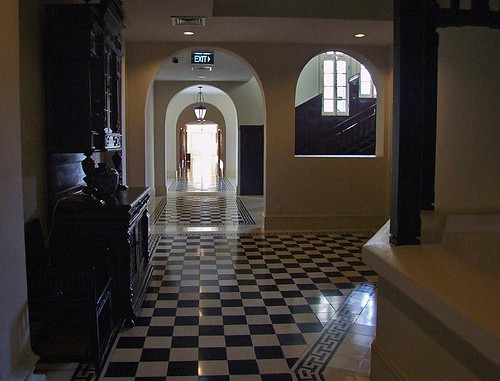Important:
Be sure that you are using the correct type of paint for the surface you intend to stencil on. Consult your paint supplier for suitable choices of paint and paint cleaners.
Depending on your project, you will need the following supplies at hand:
• Paper towels • A few disposable plates • Masking tape or painters blue tape • A Line Level and a pencil • Repositionable Spray Adhesive, (read all manufacturer instructions on the product). We recommend that you use the spray outside (if inside, then cover your floors with paper or plastic to avoid stickiness) • Stencil Brush: For Swirling Technique (see end page) use domed natural bristle head brushes. Best to avoid very stiff brushes and for Stippling and Spattering Techniques (see end page) use the flat head stenciling brushes. • A 2 inch or 3 inch foam roller and pan
Depending on your technique; a. Natural sea sponge b. Cotton rags c. Various brushes for marbling effects or other according to your Faux Painting book instructions
Before you start stenciling your walls, we recommend that you practice using the practice sheet or the surface of a large cardboard. The practice will give you a good idea of the use of repositioning spray and the amount of paint.
1. Use the line level to position your first stencil overlay on the wall. Gently, mark the wall with a pencil on the four “registration holes”. If you don’t want pencil marks on your walls, you can put tiny scraps of masking tape under the registration holes, and mark them with a pencil. Remove the pieces of tape from your wall once done stenciling. (Note: Do not use the edge of the stencil sheet as a guide to position repeat patterns; use the registration marks).
2. Spray the back of the stencil (frosty side) very lightly with the Repositioning Spray Adhesive. If the stencil is too tacky, then stick it to a cardboard to remove the excess tack.
3. Line up the stencil sheet against the registration points and gently press the stencil to the surface.
4. Start stenciling with almost no paint (Dry Brush) on your brush or roller. You will soon find out a little paint goes a long way when stenciling. Note: using a brush or roller heavy in paint will cause bleeding of the paint in between the stencil sheet and your wall. It is easier to keep adding very small amounts of paint to the area until the desired effect is achieved.
5. When you are done stenciling, remove the stencil sheet very gently. If you wish to wipe the excess paint from the back of the stencil; do so using a clean damp sponge or rag and not paper towels. Paper towels will get stuck to the adhesive on the back of the stencil. Be sure the back of the stencil sheet is dry before you paste it back on the wall. 6. Follow the repeat registration marks but make sure not to place the stencil sheet on top of wet paint.
Basic reminder of two most popular methods of stenciling:
Swirling Technique: Swirl the paint along the edge of the cut-out area in small circular motion. Slowly work the paint toward the center of the cut out while leaving the center to remain the lightest. This method gives dimensionality to your work in a simple manner.
Stippling Technique: Apply the paint by tapping or pouncing in an up and down motion. Stippling results in a textured look. It is also a desirable method for use on rough surfaces. You need to load the brush slightly heavier when stippling but best to remove excess paint by tapping the brush on a paper towel until you get a good feel for your work.













